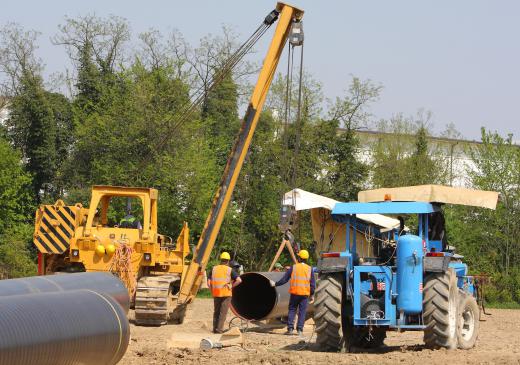The primary differences between a hoist and a crane are the ways each can move, the ability to convert them for other tasks, and the complexity of their design. A hoist and a crane are both are used to move objects. While a hoist can only lift or lower them vertically, a crane can, in addition to that, move objects horizontally as well. Some highly advanced crane designs allow the load to be rotated in three dimensions as well. Generally, the part of a crane that is used to lift and lower a load is a hoist.
A hoist and a crane may both be used to move a load, but a hoist can move it in only one direction along a straight, vertical line. Such a device is said to have one degree of freedom. A good way to visualize this is to think of an elevator. It moves up and down a shaft, also known as a hoist way, suspended by cables from a hoisting mechanism that powers its motion. The elevator is limited to traveling up and down in a straight line within that shaft.

Typical cranes can move their loads up and down in a straight, vertical line, but they can also move them horizontally both forward and backward and side to side. Most cranes can move a load in a straight line in three independent axes and can be said to have three degrees of freedom. There are some jobs for which a hoist and a crane are both suitable. Some tasks, however, require the use of a crane for greater flexibility in how and where to move the load.
A common example of this flexibility of motion is the small crane inside a claw machine game used to retrieve toys as prizes. The operator positions a crane by moving it forward and backward as well as left and right and presses a button to drop a claw. An open claw drops vertically into a pile of toys, closes, and is retracted upward with or without a toy in its grasp. There would be little point to this game without the crane feature. With a hoist only, the operator could only lower and raise the claw in the same place every time, which requires no skill.
Specialized cranes called rotary cranes typically have this same capability, but also incorporate rotational motion for added performance. They may be able to rotate in up to three independent axes as well as to move in a straight line in those three directions. These rotations are known as roll, pitch, and yaw. This allows a rotary crane to operate with up to six degrees of freedom, although some models are designed with fewer degrees of freedom. Rotary cranes may be used in robotic applications, for example, or in industrial transportation applications such as on trucks, locomotives, or ships.
Another difference between a hoist and a crane is that a many cranes can be converted for other operations aside from moving a load. In demolition, for example, a wrecking ball may be added for the purpose of bringing down an unwanted structure. For construction purposes, a scoop may be used to gather up dirt or waste materials that are to be moved. Hoists are not generally designed for conversion for other uses beyond lifting and lowering a load.
Hoists are commonly installed as sub-components of cranes. They are typically the mechanisms used to lift and lower the loads moved by cranes. This is another way a hoist and a crane differ. Cranes are more complex devices than hoists and are not sub-components of hoists.
